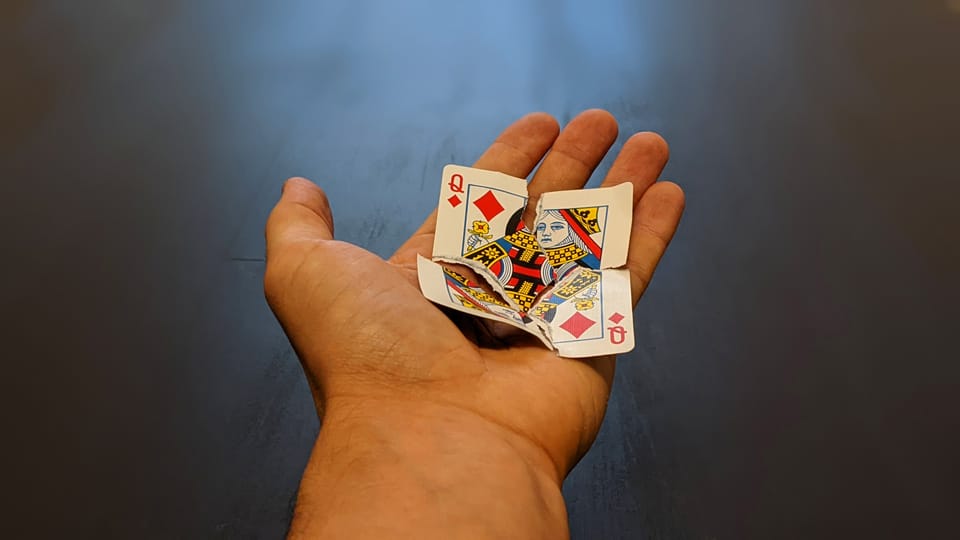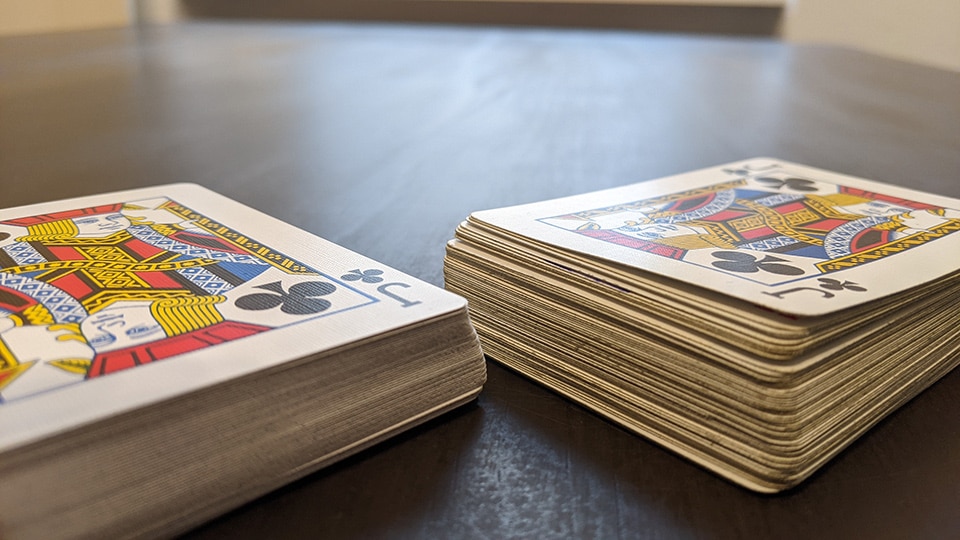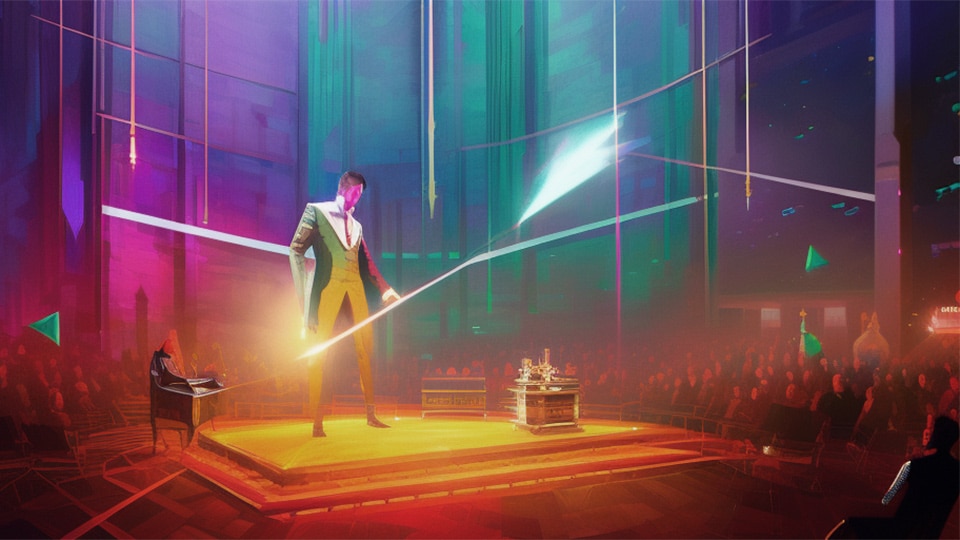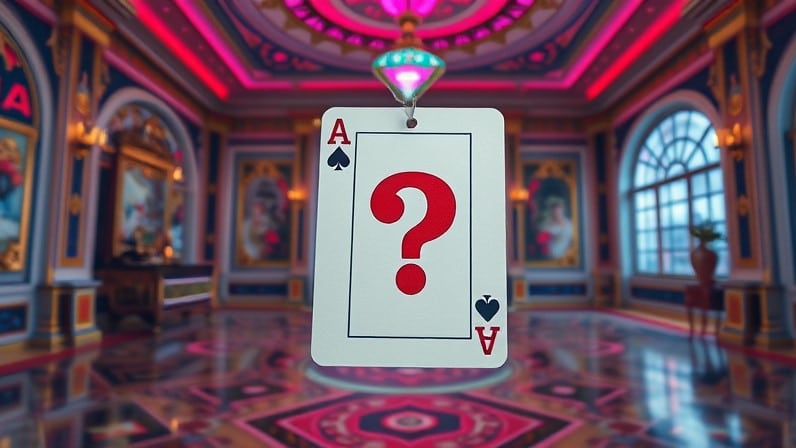What is a Mentalist?
We believe magic is exclusive to fantasy stories and myths, a moment of wonder to fill those who experience it with awe. Yet there are people who seemingly read minds, defy physics before our eyes, and make predictions only an all-knowing person could make. A casual wave of the hand a knowing smile, they can ask audience members to think of a memory so close and dear to them and yet reveal it moments later with stunning accuracy to a crowd of hundreds. This is mentalism, a charismatic form of entertainment mixing psychology, illusion and theatrical artistry into one night of astonishment.

In this article, we’ll explore what mentalists do, uncover the secrets behind their performances, and explain why their shows are so captivating. We’ll also look at the challenges they face in making their performances visually appealing and highlight the career of Derren Brown, a mentalist I value highly.
Can mentalists really read minds?
So, with such personal accuracy, these people must all be multi-millionaires, right? Can they not just tell you tomorrow’s winning lottery numbers and spread joy across the land? Well, not exactly. Mentalists are intelligent and highly skilled tricksters playing with the unseen in plain sight, closely observing thoughts, emotions, and decisions to create illusions that seem to defy reality. Mentalists rely on many techniques to guide your focus and attention, often hiding the simplest truths in plain sight.
Why mentalists don't actually read minds – and still amaze
At its heart, mentalism is the art of crafting an illusion so convincing, it seems as though the performer possesses supernatural mental powers. Even when we know it isn’t real, the experience can feel like magic. These performers are masters of molding your mind to their will, guiding you to seemingly impossible conclusions. Though a mentalists performance isn’t just about the big finale of the trick coming to fruition, it’s about the storytelling and the connection to the audience along the way. They carefully weave their stories to find common ground with them, creating a more personal bond, raising suspense and at times elicit emotional responses. The best mentalists don’t just perform tricks—they create moments that challenge what you believe is possible, make you feel something real, and at times leave you wondering if you’ll ever see the world in quite the same way again.
How do Mentalists achieve their mindreading effects?
The key to being a successful mentalist is to use a combination of methods that keep the audience blissfully unaware of how the trick was done. While each performer has their own style, most rely on a mix of classic techniques, modern technology, and psychological principles. Mentalists rely on many techniques to guide your focus and attention, often hiding the simplest truths in plain sight. So, lets dig deeper into some but not all of the secrets behind the mental magic.

1. Peeking
“Peeking” really is exactly what you’d expect. Nothing too psychological here, just a straightforward yet powerful technique which involves secretly obtaining information from an audience member without them even realising it! For example, the participant could be asked to write a word on a piece of paper and place it in a sealed envelope, only to find the mentalist uses a secret hidden slit or transparent section they can peek through. Alternatively, perhaps a chosen card could be subtly seen during shuffling through clever sleight of hand.
2. Preshow Techniques
At times for the mentalist, the work begins before they even start the performance. Occasionally, they can actually gather information about their audience in advance though casual conversations, questionnaires or even social media research. Through this subtle data collection, they can give the impression to the audience that they have in fact learnt something in real time during the performance.
3. Advanced Technology
As technology has developed, mentalists have adopted various gadgets that can improve their performances. These devices, for example, could just look like ordinary objects such as a pen, a deck of cards or a watch; but they’re in fact all equipped with hidden technology that transmits information directly to the performer. Imagine the participant is handed a piece of paper to write a secret message and all seems reasonable, yet unbeknownst to them, there are secret sensors that record exactly what is being written and transmit it straight to the mentalist through a secret hearing or display device! With every technological advancement, mentalists gain new opportunities to make their shows more spectacular and impressive. However, in a world where we are well aware of the power of technology, the true art will lie in making us believe that it is solely the human mind behind the magic.

4. Manipulating Choices
This one is much more psychological, and these methods really allow the mentalist to guide participants to make decisions that they believe are entirely their own. This subtle manipulation can be achieved through ambivalent verbal suggestions or cues, and changes in body language to guide people toward a specific decision, always making them believe that they have acted independently.
Mentalists often claim to use this method, but in reality, it is usually the three previously mentioned methods that are employed. Only in the rarest of cases would a mentalist attempt to achieve an effect in this way, as too many things could go wrong. And when performing a show in front of an audience, they would want to avoid such risks. That’s why mentalists rely on the first three methods and then claim to have used psychological tricks and read the participants’ body language.
Their methods combine to create genuinely mesmerising experience for viewers and participants that can truly blur the line between reality and illusion.
The Challenge of Making Mentalism Entertaining
Despite all these methods, it takes a true mentalist to really hold the attention of an audience and make a performance visually entertaining. How do they keep the intrigue and the suspense so masterfully without the viewers getting bored, as not everyone may be directly involved in the act. There isn’t always a spectacle like in traditional magic such as disappearing props and the performer being ‘sawed in half’! The truth is, a skilled mentalist must ensure that the viewers minds are constantly at work, be it thinking of a potential outcome, disbelief, or trying to acknowledge what it is they’ve just seen. They must also rely heavily on storytelling, theatrical elements and humour to keep their shows visually entertaining, truly allowing their charm and personally to shine. The audience’s attention can be achieved through suspenseful music during the act, subtly helping to guide their emotions like in a movie, or perhaps even interactive elements or something to keep focused on throughout the show. I’ll explain an example from one of the greats Derren Brown shortly. Ultimately, the goal is to create a performance that is as entertaining as it is thought-provoking, just like a theatre show.

The Dark Side of Mentalism
There is a darker side to mentalism however, and there are some who unfortunately misuse these techniques for personal gain. These individuals often confidently claim to have real psychic abilities, presenting themselves as ‘mediums’ who can contact the dead or perform miraculous feats. They prey on the vulnerable—those grieving or desperate for answers—and use their position of power to exploit their emotions for money. Unlike ethical mentalists, who aim to entertain and inspire, these fraudulent ‘psychics’ use deception to manipulate and profit from their victims. It’s a dark reminder of the influence these people can have on the mind, and how powerful these techniques can be, especially when placed in the wrong hands.
Derren Brown: A Master of Mentalism
So now, let’s discuss a pioneer of the craft, and perhaps one of the most well-known mentalists of the modern day, Derren Brown. He, like many other mentalists, started out his career as a traditional magician, relying on techniques such as sleight of hand and misdirection to create his illusions. He collaborated with a mainstream UK television channel, who subsequently built a lot of excitement and intrigue around his first show ‘Mind Control’, in which he demonstrated seemingly impossible feats such as predicting lottery numbers and influencing people’s decisions. This show and those that followed afterwards amazed audiences around the nation, and people were hungry for more as he weaved into his performance’s themes like belief, morality and the power of suggestion. What truly sets him apart is his ability to blend psychological insight with theatrical flair in his live shows.
In one of his live shows, he seemingly made four participants levitate a table in midair and guessed audience members’ deepest secrets, constantly keeping them in suspense and questioning reality. At the end, he asked if anyone had noticed the man in the gorilla suit walking across the stage. Silence. No one had seen him. Then, he played a replay, and there he was—clear as day. The audience had missed it entirely, too focused on what he had directed their attention toward.
Remember the earlier line about things hidden in plain sight? That’s exactly what happened here—just like in this article, where you’ve been reading without realizing the exact same phrase appeared twice. Did you catch it? (It was: Mentalists rely on many techniques to guide your focus and attention, often hiding the simplest truths in plain sight.)
Why Mentalism Captivates Us
Mentalism continues to be an encapsulating form of entertainment as it taps into something deeper many of us have, a craving for the unknown and the fascination with the human mind.
It challenges our beliefs, stirs our imagination, and invites us to question what’s possible. Whether it’s a world-class performer like Derren Brown or a local mentalist just starting out, the effect is always the same—a sense of awe and wonder. Mentalism isn’t just about tricks, it’s about connection. So, the next time you have the opportunity to see a mentalist in action, let yourself be immersed and amazed, and you’ll soon find the true magic is in your mind.
Frequently Asked Questions about Mentalism
Magicians and mentalists use the same methods and principles of deception. The difference lies in the presentation and the goal of their performance:
Mentalists suggest effects of mind-reading and create the impression that they can achieve mental phenomena, such as telepathy or predictions, through psychological techniques, suggestion, or observation. Although they claim to use psychological tricks, mentalists often rely on classic methods of magic, such as peeking (secretly obtaining information), preshow techniques (gathering information beforehand), or misdirection (deliberate distraction) to create these illusions. They intentionally distinguish themselves from traditional magic and focus exclusively on mental effects that primarily take place in the audience’s minds.
Magicians, on the other hand, use the same fundamental principles and techniques but with a different goal: they present visual and tangible illusions that seem impossible, such as making objects disappear or appear, or levitate. Their focus is on visual effects that take place physically in the space. They do not aim to exclusively demonstrate psychological abilities. However, many magicians include one or two mentalism effects in their repertoire to make their performance more varied and entertaining.
Both art forms share a common foundation of techniques but differ in how they are presented and the stories they tell the audience. Mentalism often feels subtle and mysterious, while magic is lively and spectacular.
The choice between a magician and a mentalist depends on the atmosphere and goals of your event. If you want to amaze your guests with visual, captivating tricks and create entertaining moments, a magician is the ideal choice. A mentalist, on the other hand, offers a quieter, more thought-provoking experience through psychological effects and the illusion of mind reading. Both performers provide extraordinary experiences but in different ways.
For a focused and attentive audience, a mentalist can create a unique, mysterious atmosphere with their deep and intriguing performances. However, if you’re looking for a livelier, more energizing element that can entertain even less focused guests, a magician would be the better option. With the visual power of magic, they can captivate the audience’s attention even in louder or more chaotic environments, creating unforgettable moments. In summary, mentalists require a concentrated audience, while magicians excel with their visual magic in both focused and more relaxed, lively settings.
No, mentalists cannot actually read minds. What they present is the result of using classic magic techniques skillfully to create the impression that they possess supernatural abilities. These techniques include:
- Peeking: Secretly obtaining information that a spectator has written down without them noticing.
- Preshow Techniques: Collecting information about the audience beforehand, which is then used during the performance to create astonishing effects.
These and other methods produce the illusion of mind reading but are entirely based on psychological techniques and cleverly applied magic.
Mentalists seemingly read minds by using a combination of classic magic techniques, psychological principles, and modern technology. Commonly used methods include:
- Peeking: Secretly glancing at information a spectator has written down without them noticing.
- Preshow Techniques: Gathering information about the audience before the performance to create astonishing effects during the show.
- Hidden High-Tech: Seemingly harmless objects may be equipped with sensors or transmit information to the mentalist discreetly.
By cleverly combining these and other techniques, mentalists create the illusion of being able to read minds.
Psychology plays a smaller role in mentalism than many mentalists may lead people to believe. While psychological principles such as suggestion, body language observation, and manipulation of perception are used, it is primarily classic magic techniques that form the core of most mentalism shows. The idea that mentalists possess deep psychological knowledge or extraordinary mental abilities is more a part of their marketing and presentation strategy than the actual foundation of their art.
A mentalist does not need formal education or special qualifications. Anyone can learn the skills necessary to perform as a mentalist. While some mentalists may have psychological degrees or similar qualifications, this is often more about marketing. The quality of the show depends more on the mentalist’s practical skills, magic techniques, and artistic presentation style.
A good mentalist is able to evoke emotional experiences in the audience and captivate them through their presentation. Since mentalism primarily takes place in the minds of the spectators, the visual element is often lacking. The mentalist must skillfully compensate for this absence of visual effects. An experienced mentalist will still create visually appealing moments on stage, such as bringing audience members onstage, having them visibly write something down, or using similar techniques to add some level of visuality to the show. Through such engaging presentations and charismatic interaction, good mentalists manage to captivate the audience and convincingly convey the illusion of mind reading, rather than lulling them to sleep with numerous similar mind-reading effects.
However, if you haven’t seen the mentalist before, it can be difficult to judge. To make it easier for you to recognize good mentalists, I’ve written a blog post on the topic. Although it’s focused on magicians, the same quality criteria apply to mentalists. Here’s the article.
The cost of booking a mentalist can vary greatly and depends on factors such as experience, travel time, duration of the performance, and demand for the mentalist. Typically, you can expect prices ranging from €900 to €3000, depending on the scope of the show and the event’s requirements.
For a more detailed overview of the prices you can expect when booking a mentalist, check out my article “What Does a Magician Cost?“. Don’t be misled by the title – since mentalists are a subcategory of magic, the prices listed there also apply to mentalists. It’s best to take a look at the prices for event magicians, as these are most comparable.
The cost of booking a mentalist per hour depends on the type of booking. A mentalist who walks around and interacts directly with guests typically charges between €300 and €900 per hour. A mentalist offering a 60-minute stand-up show, on the other hand, is usually priced between €900 and €3000, depending on the complexity of the show and the required equipment.
For a more detailed overview of the prices you can expect when booking a mentalist, check out my article “What Does a Magician Cost?“. Don’t be misled by the title – since mentalists are a subcategory of magic, the prices listed there also apply to mentalists. It’s best to take a look at the prices for event magicians, as these are most comparable.
You should avoid booking a mentalist if it’s likely that the audience will be inattentive or the space at your event will be loud. Since mentalism heavily relies on focus and concentration, a noisy environment or a distracted crowd can negatively impact the performance. Similarly, you should not book a mentalist if the guests are mentally exhausted, such as after a long conference. In such cases, it’s better to book a magician, as their visual art requires less concentration and can entertain the audience without constant mental effort. The visual nature of magic works well in loud and chaotic settings and helps maintain the audience’s attention more easily.
No. Mentalists like Patrick Jane from “The Mentalist” do not exist in reality. However, there are mentalists – show performers who use classic techniques from magic to create mind-reading effects and simulate extraordinary observational skills and deep psychological insight. These artists were likely a major inspiration for the character of Patrick Jane.
In the series, Patrick Jane is nearly infallible in his assessments and solves crimes with seemingly supernatural observational skills. In reality, no one possesses such abilities – otherwise, mentalists would be highly sought after by law enforcement, and we would regularly see job postings for them. 😉
No, a real mentalist could not solve crimes like Patrick Jane. Mentalists are show performers who rely on deception, psychological tricks, and classic magic techniques. Their seemingly extraordinary people-reading skills and mind-reading abilities are just illusions, created using techniques such as peeking and pre-show methods.
None of these tricks would actually help in solving real crimes, as they are based on deliberate manipulation and pre-gathered information rather than genuine mind-reading or superior intuition. Patrick Jane is a fictional character who dramatically exaggerates mentalist techniques.
The mind-reading effects in “The Mentalist” are unrealistic because no human truly possesses such abilities. No one can draw conclusions with the supernatural precision and certainty that Patrick Jane demonstrates.
However, there are show performers who use techniques and methods from classic magic to simulate seemingly extraordinary deductive abilities, psychological insight, and mind-reading effects.
Attending such a show can provide a similar experience to watching The Mentalist – but with the understanding that it is based on skillful deception rather than real supernatural abilities.
Fabian Schneekind
I have been dedicated to the art of magic for over 19 years, 10 of which have been full-time. My work takes me to various events both nationally and internationally. I’ve performed for renowned companies such as Lufthansa, Siemens, Deutsche Bank, Adobe, Würth, Pfizer, and Deutsche Telekom. International highlights include an exclusive birthday party in Los Angeles and my performances at major networking events.
I have shown my magic to top models at the Fashion Week and to bands like Rammstein. But I also enjoy performing at your grandmother’s 80th birthday. For me, magic is the best way to bring people together and momentarily forget about topics like status and wealth.
In my blog, I share this valuable experience to offer useful tips to event planners and aspiring magicians.







